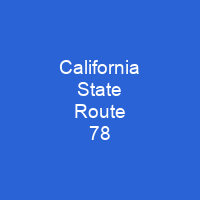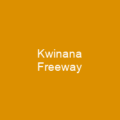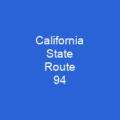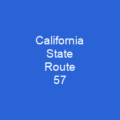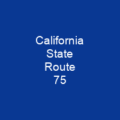Discovering the Journey of State Route 78: A Highway Through Time
Imagine a road that weaves through time, connecting cities and communities with its winding path. That’s what State Route 78 (SR 78) is all about in California. This state highway spans from Oceanside to Blythe, passing through the Cuyamaca Mountains and Imperial County. It’s a journey that begins in 1871 and continues into the modern era, with twists and turns that reflect the changing landscape of Southern California.
The Early Days: From Toll Road to State Highway
SR 78’s history is as rich as its route. It started life as the Old Banner Toll Road in 1871, connecting Julian and Banner. This road was a vital link for travelers and commerce, but it wasn’t until 1925 that it saw significant changes. The road remained in service until 1930 when an agreement was reached to share construction costs with the state highway system.
Designation and Construction
In 1934, SR 78 was officially designated as part of the growing network of highways across California. However, its completion wasn’t immediate; it took until 1959 for the route to be fully connected east of Brawley. The road’s construction was a testament to the perseverance and vision of those who believed in connecting communities through better infrastructure.
Freeway Dreams and Reality
The dream of converting SR 78 into a freeway began in earnest in the late 1950s and early 1960s. The San Diego Chamber of Commerce pushed for this transformation, seeing it as a way to improve traffic flow and economic development. However, funding and environmental concerns delayed progress.
By 1973, the section between I-5 and Melrose Drive was upgraded to full freeway standards. This was just one step in a long journey that saw SR 78 transformed from dirt roads to paved highways, and eventually into freeways. The road’s evolution mirrors the broader changes in California’s transportation infrastructure over the decades.
Modern Challenges and Solutions
The modern era of SR 78 brought new challenges but also innovative solutions. In the late 1980s, a cost-sharing plan was proposed to widen the road between Oceanside and Escondido. This project faced numerous hurdles but ultimately succeeded in improving traffic flow and safety.
From 1994 to 2006, several projects were undertaken to enhance SR 78’s capacity and functionality. These included realignments, renovations, and the construction of new interchanges. Each step forward was a testament to the ongoing commitment to improving this vital route for both residents and travelers.
Future Horizons
Looking ahead, plans are in place to further improve SR 78. A bypass around downtown Brawley is set to open soon, while additional interchanges and improvements are on the horizon. These projects aim not only to enhance traffic flow but also to ensure that this historic route remains a vital link for years to come.
As we continue to navigate the complex landscape of transportation in California, SR 78 stands as a symbol of progress and resilience. Its journey from a simple toll road to a modern freeway is a story of adaptation and innovation, reflecting the dynamic nature of our state’s development.

SR 78 is more than just a highway; it’s a story of progress, perseverance, and the ongoing quest for better transportation. As we continue to shape our future, this route will undoubtedly play an essential role in connecting communities and driving economic growth.
In conclusion, State Route 78 has come a long way since its humble beginnings as a dirt road. Its journey is a testament to the power of vision, hard work, and innovation. As we look towards the future, SR 78 will continue to evolve, ensuring that it remains a vital artery for Southern California.
You want to know more about California State Route 78?
This page is based on the article California State Route 78 published in Wikipedia (retrieved on December 5, 2024) and was automatically summarized using artificial intelligence.
